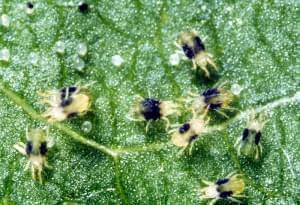Without Federal Regulations, States Are On Their Own To Enforce Safety In Marijuana Industry
For every crop in the United States, the Environmental Protection Agency carries out a rigorous set of tests to determine which pesticides are safest. How and when a pesticide is used can depend on how that crop is consumed by the average person — is it ingested, inhaled or applied topically?
It’s a precise science that aims to keep consumers safe from potentially toxic residues. But, like most federal regulations, none of it applies to the marijuana industry.
In lieu of government research, a state with legal marijuana, like Colorado, is left to develop its own set of rules. That can leave cannabis growers largely on their own.
Whitney Cranshaw, an entomologist at Colorado State University, said many marijuana growers look to the internet for best practices.
“In terms of pest management advice, I have never seen so much gross misinformation, so much junk science,” he said.
As an extension specialist at CSU, Cranshaw developes pest management programs for horticultural crops, but because cannabis is still federally illegal, he can’t touch it.
“It drives me nuts,” said Cranshaw. “(I) could make more progress in terms of helping people by providing information on these crops (...) than anything that I’ve ever worked with.”
In Colorado, state officials have used existing EPA research to create a list of which pesticides marijuana growers can use. They’ve selected more than 300 products that are so low in toxins — many of them are organic — they don’t leave behind harmful residues. And their federally regulated labels allow them to be used on virtually any crop.
Still, some growers are caught using pesticides they’re not supposed to.
Inside a warehouse near downtown Denver, Cynthia Andersen walks along rows of marijuana plants. Fans gently oscillate under blaring white lights to create a synthetic tropical climate. Andersen and her husband have run this grow operation nearly a decade, starting when Colorado legalized medical marijuana.
“It was just an interest of my family’s to get into it and be on the forefront of a new industry,” she said.
She has around 450 plants, which she said is small for this industry (the state does not track the size of each licensed operation), and unlike large facilities that house thousands of plants, Andersen can give each plant individual attention.
“We look at our plants everyday,” she said. “We know if she turns yellow or if she’s not getting enough water or if she’s getting too much light.”

Many marijuana crops are grown indoors, making them susceptible to pests like powdery mildew and spider mites.
And that can be crucial for controlling pests. Things like spider mites or powdery mildew will decimate a crop of cannabis, which is why growers like Andersen rely on pesticides. But anyone caught using a pesticide that’s not approved by the state can have their crop removed by state officials and be fined up to $2,000. Repeat offenders eventually will be shutdown.
Andersen keeps a copy of the state’s pesticide regulations at her desk for reference. She said they’ve never used an unapproved product, but she hears rumors that others in this industry don’t follow these rules.
“We hear about the horror stories at other grows and what is done and what isn’t done,” she said.
Andersen assumes growers would risk using an illegal pesticide if a pest problem gets so out of control they need something stronger to help manage it.
“They don’t have any choice but to use that to get rid of whatever it is that their plants have,” she said. “You’re talking about millions and millions and millions of dollars of growing plants.”
As with any crop, the Colorado Department of Agriculture will take random samples of marijuana. That’s how it discovered 22 cases of pesticide misuse in 2018. Because most of the cases are still pending, Harvest Public Media could only access the records for four of them.
The documents included pesticides not permitted for use on “plants being grown for sale or other commercial use.” But according to Cranshaw, these products are commonly used on crops and not especially harmful. He said he thinks the growers could have just made a mistake.
“There’s a massive amount of confusion and it’s quite chaotic,” he said. “(Which) makes it really difficult for growers to know what they’re supposed to do.”
In one of the cases, the pesticide was later approved for use by the state, so it was really a matter of completing the required paperwork. In another instance, workers were not given respirators for applying a certain pesticide, though the EPA's Worker Protection Standard for agricultural employees applies to those working with any crop, including marijuana.
One worker at another grow operation reported his employer for pouring pesticides down the storm drain.
Officials with the Colorado Department of Agriculture say things have improved since the state started regulating pesticides in the marijuana industry four years ago.
While some states have no regulations in place, Washington, Oregon and Nevada follow a similar model as Colorado. Illinois, which may pass recreational marijuana this spring, will likely use a similar one.
In Part 1 of our series, read more about the risks of aerial pesticide application. For more on the law meant to protect agricultural workers from pesticide dangers, and the EPA’s admission that good incident data does not exist, read Part 2 of our series.
Follow Esther on Twitter: @estherhonig

